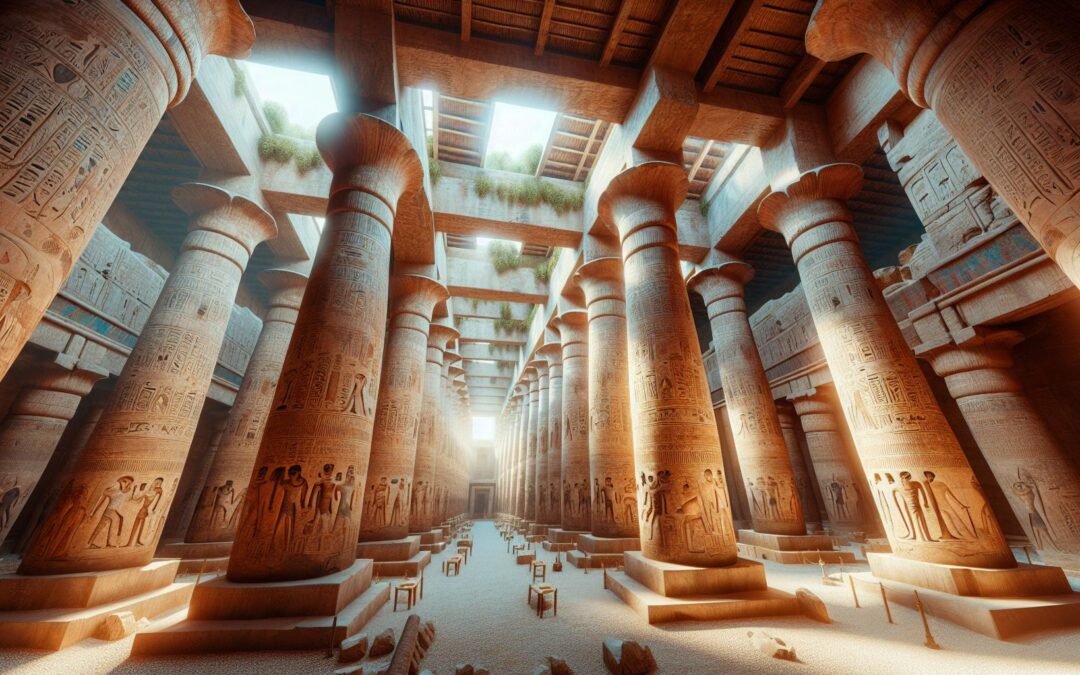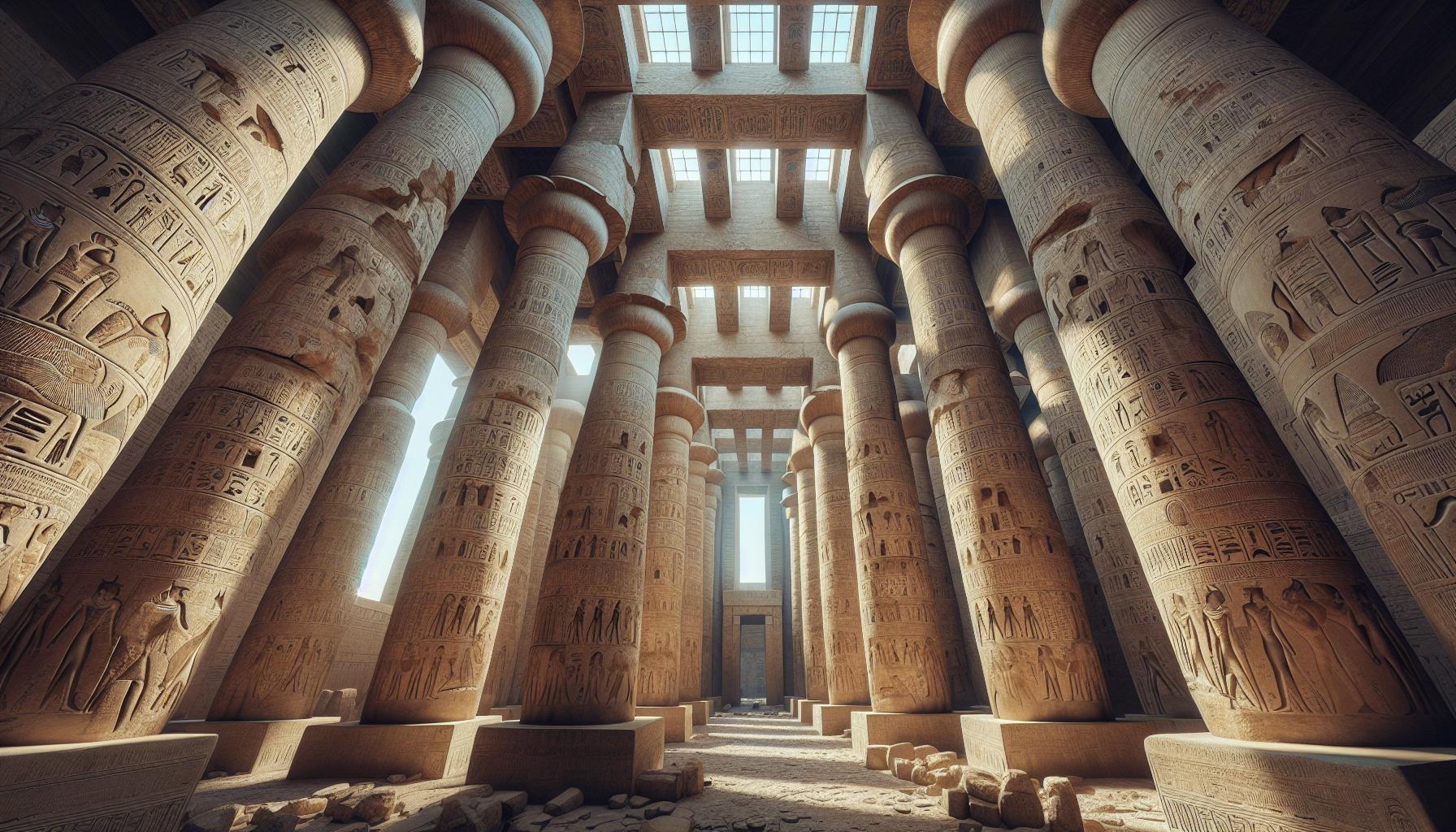The Temple of Amun-Re at Karnak stands as a monumental testament to ancient Egyptian architecture and religious devotion. This grand temple complex, dedicated to the sun god Amun, showcases the ingenuity and artistry of a civilization that flourished for thousands of years. Among its most striking features is the Hypostyle Hall, a vast expanse supported by towering columns, which served both a spiritual and practical purpose. As one of the largest religious structures ever built, the Temple of Amun-Re and its Hypostyle Hall reflect the cultural and political power of Thebes during the New Kingdom. This article delves into the artistic significance and historical context of these iconic structures, highlighting their role in the evolution of ancient Egyptian art and architecture. Understanding these elements offers invaluable insight into the beliefs and practices of a civilization that continues to captivate the world today.
Temple of Amun-Re and Hypostyle Hall in AP Art History
The Temple of Amun-Re at Karnak stands as a monumental testament to ancient Egyptian architectural ingenuity and religious fervor. Its expansive layout and intricate designs highlight the deep-rooted spiritual beliefs and the socio-political landscape of the time.
Historical Context
The construction of the Temple of Amun-Re began during the Middle Kingdom around the 20th dynasty and continued into the New Kingdom. It served as the chief center of worship for Amun, the principal deity of Thebes. The site reflects the rise of Thebes as a political and cultural hub, especially during the reigns of prominent pharaohs like Hatshepsut and Ramses II. The temple’s development showcases shifts in religious practices and the increasing power dynamics of ancient Egypt.
Architectural Significance
The architectural grandeur of the Temple of Amun-Re reflects ancient Egyptian artistry. The complex features the Hypostyle Hall, renowned for its 134 massive stone columns, each intricately decorated with hieroglyphics and vibrant carvings. The hall, spanning 50,000 square feet, serves both ceremonial purposes and as a demonstration of the enduring influence of Amun. The temple’s layout follows a traditional axial alignment, emphasizing the transition from the profane to the sacred, which is characteristic of ancient Egyptian religious architecture.
Hypostyle Hall: A Closer Look
The Hypostyle Hall in the Temple of Amun-Re represents a stunning achievement in ancient Egyptian architecture. Its impressive scale and intricate design underscore its significance in religious practices and communal gatherings.
Design Elements
The Hypostyle Hall features 134 towering columns, each exceeding 10 meters in height. These columns are adorned with detailed hieroglyphics and symbolically rich carvings, often depicting gods, pharaohs, and religious texts. The hall’s roof, originally supported by these columns, created a grand space that allowed natural light to filter through clerestory windows. A combination of massive stone and precise engineering highlights the advanced construction techniques used during the New Kingdom period. A central aisle, flanked by taller columns, effectively draws the eye to the rear sanctuary, maximizing the hall’s visual impact.
Functionality and Purpose
The Hypostyle Hall served multiple functions within the Temple of Amun-Re. As a space for worship and rituals, it facilitated large gatherings of priests and believers. The hall also acted as a transitional area, merging the sacred sanctum with the outer precincts of the temple complex. This layout emphasized the importance of communal participation in worship while allowing for direct access to the inner sanctum, where sacred rites occurred. The hall’s design effectively reinforced the ideals of divine presence and accessibility, reflecting the religious and social dynamics of the era.
Artistic Features of the Temple
The Temple of Amun-Re at Karnak showcases numerous artistic features that reflect ancient Egyptian religious beliefs and architectural prowess, particularly in the Hypostyle Hall.
Carvings and Reliefs
Carvings and reliefs decorate the columns, walls, and ceilings throughout the temple complex. These intricate depictions portray gods, pharaohs, and significant religious narratives, emphasizing their importance in Egyptian culture. The reliefs exhibit precise craftsmanship, often incorporating polychrome finishes that enhance visual impact. Notable examples include images of Amun-Re depicted with a falcon head, symbolizing divine protection and power. The careful arrangement of these artworks tells stories of triumph, honoring pharaohs and the gods, thereby reinforcing royal authority and divine favor among worshippers.
Symbolism in Art
Symbolism permeates the artistic elements within the temple. The use of color, motifs, and iconography carries profound significance. For instance, the color green often represents fertility and rebirth, while blue symbolizes the Nile and the heavens. The choice of these symbols connects the natural world with the divine, reinforcing the relationship between gods and the landscape. Additionally, the columns in the Hypostyle Hall, designed to mimic papyrus plants, represent both life and regeneration, expressing the concept of growth and continuity. This integration of symbolism into the architectural and artistic design invites worshippers to engage more deeply with their faith, making spirituality a visceral experience in the sacred space.
Cultural Relevance in Ancient Egypt
The Temple of Amun-Re and Hypostyle Hall exemplify the cultural and religious ethos of ancient Egypt. These structures significantly influenced various aspects of social and religious life during their time.
Religious Practices
Religious practices in ancient Egypt revolved around the worship of deities, notably Amun-Re. Rituals conducted in the temple included daily offerings, grand festivals, and elaborate ceremonies, facilitating communication between the people and their gods. The Hypostyle Hall functioned as a gathering space for worshippers, where they participated in communal activities that reinforced communal identity. High priests played crucial roles in mediating these interactions, ensuring adherence to religious traditions. The architectural design of the temple complex reflects the profound significance of these rituals, as the hierarchy of space emphasized the sanctity of the interior, engaging worshippers in a transcendent experience.
Influence on Later Architecture
The architectural innovations of the Temple of Amun-Re, particularly those seen in the Hypostyle Hall, set precedents for future religious structures. Attributes such as the use of massive columns, extensive decorative reliefs, and clerestory windows became integral elements in later temple design across various cultures. Greek and Roman architects adopted these features, inspiring classical temple architecture. The emphasis on grandiosity and intricate design influenced not only Egyptian structures but also left a lasting impact on religious architecture worldwide, demonstrating the temple’s enduring legacy beyond its time. The Temple of Amun-Re and its Hypostyle Hall stand as monumental testaments to ancient Egyptian artistry and spirituality. Their architectural grandeur and intricate designs reflect the deep-rooted religious beliefs and social structures of the time. This iconic site not only served as a center for worship but also played a crucial role in uniting communities through shared rituals and celebrations. The innovations seen in the temple’s construction have left an indelible mark on architectural history. The influence of the Temple of Amun-Re extends far beyond its original context, shaping the design of future religious structures across various cultures. Its legacy continues to inspire and educate those who seek to understand the complexities of ancient Egyptian civilization.


